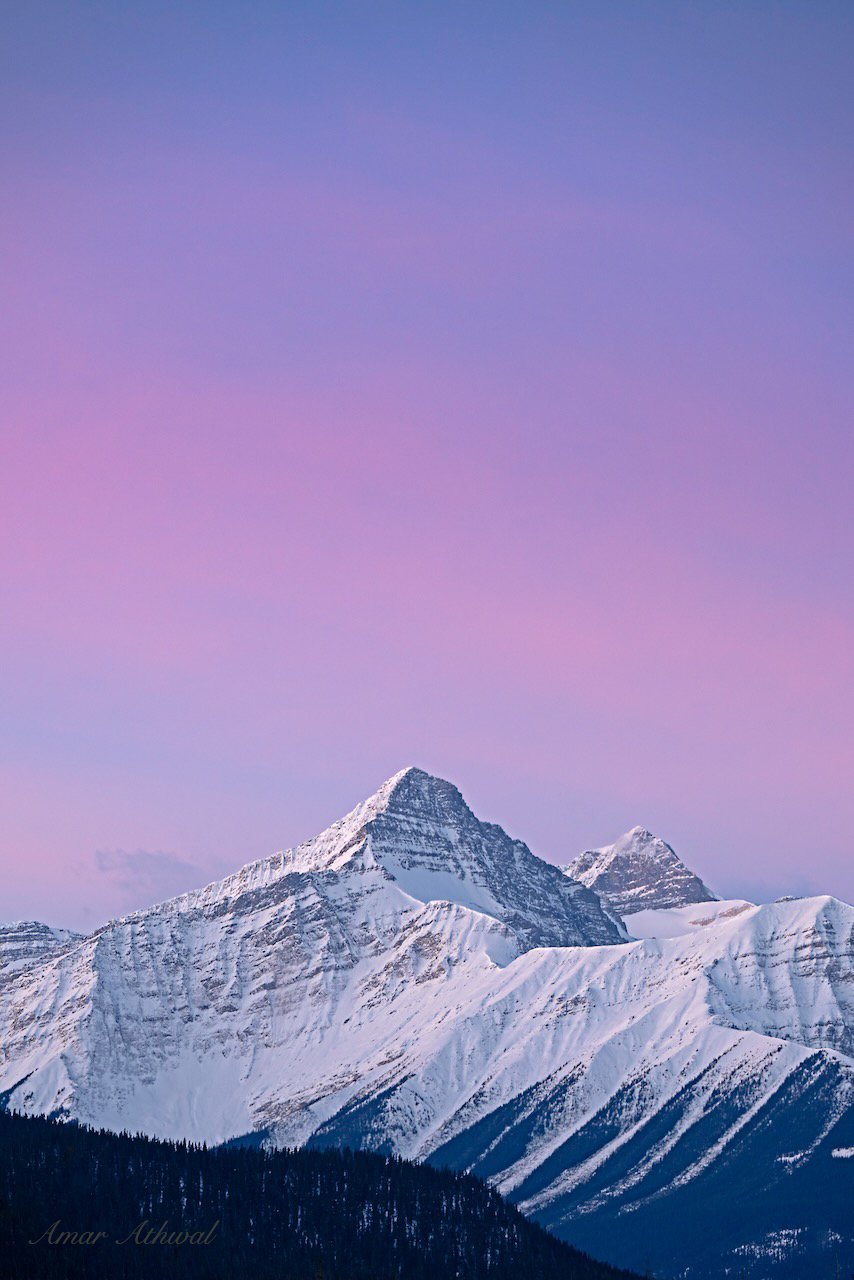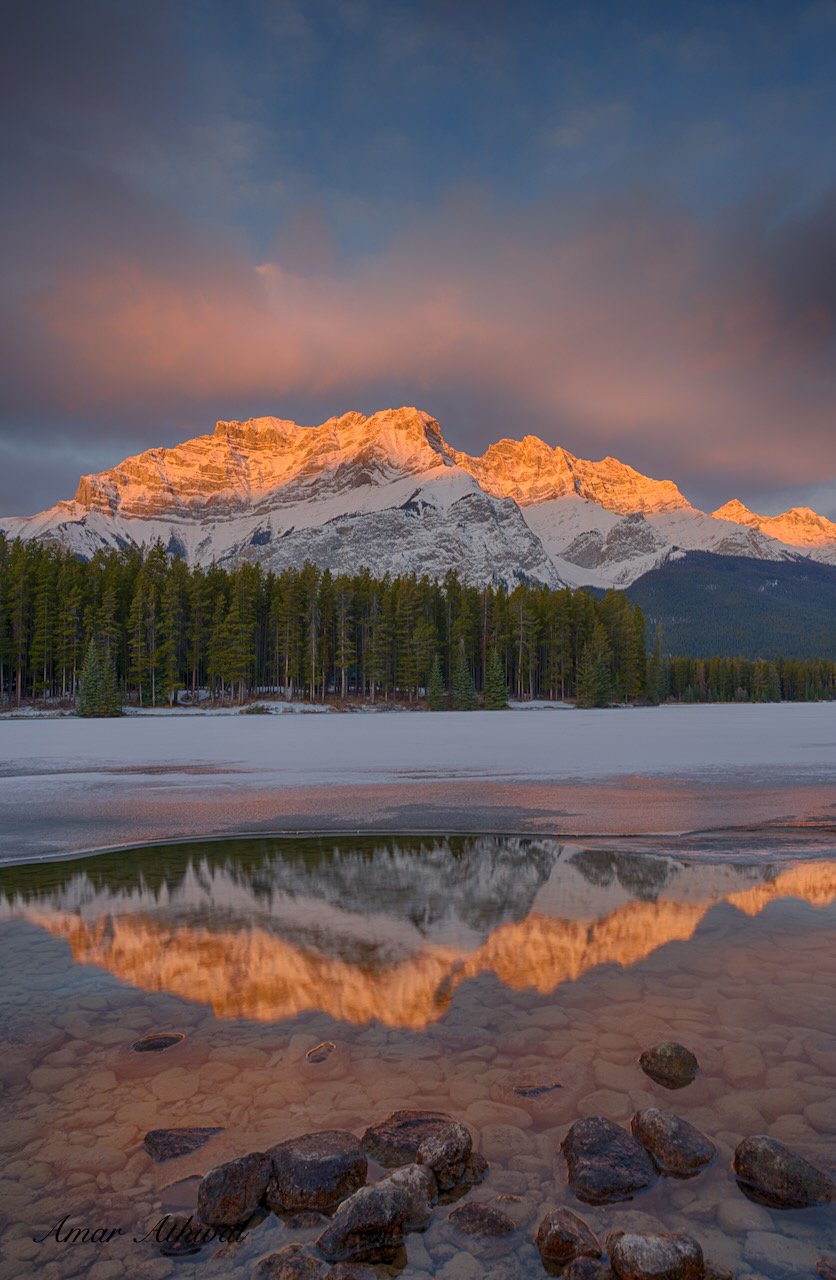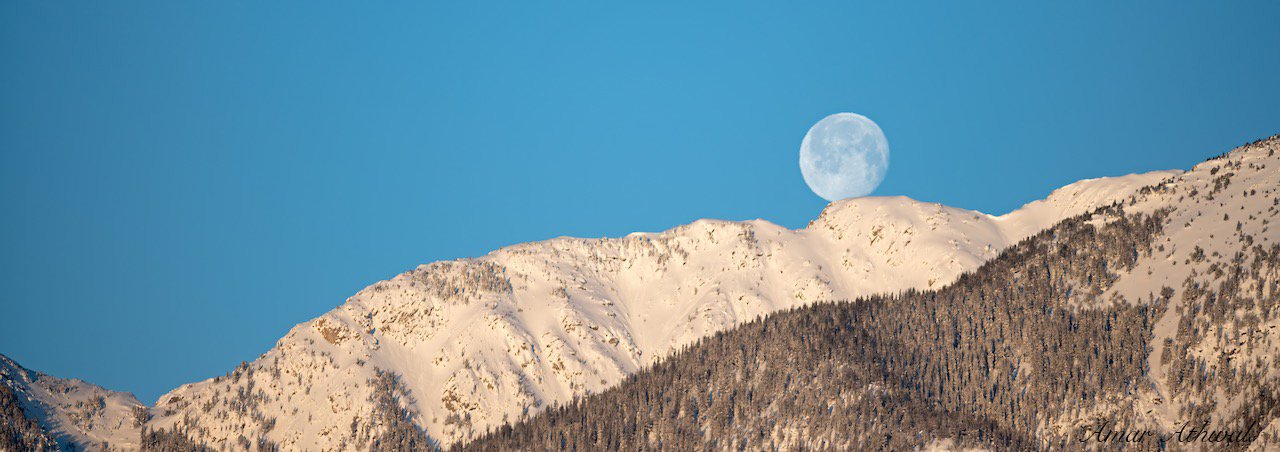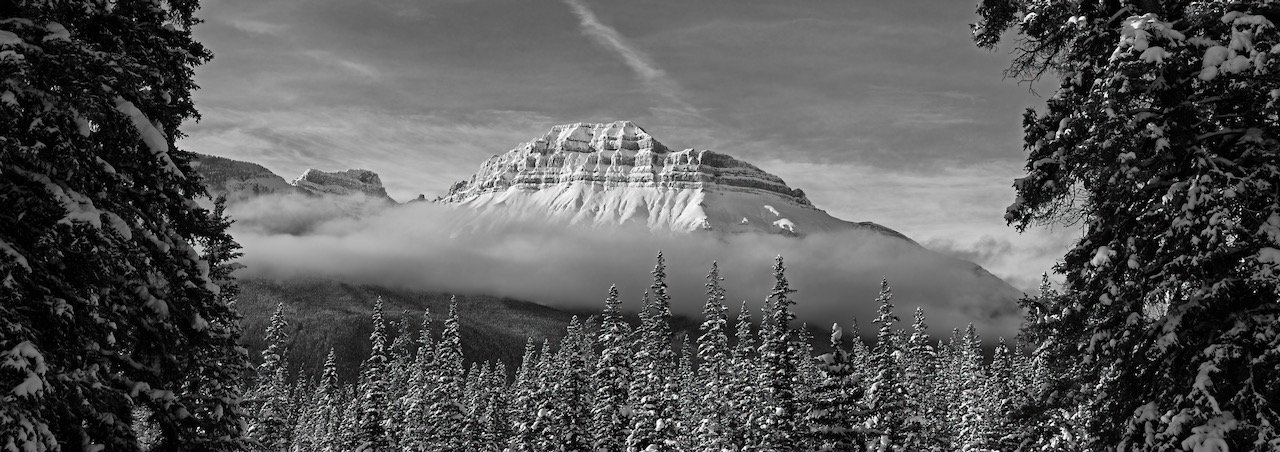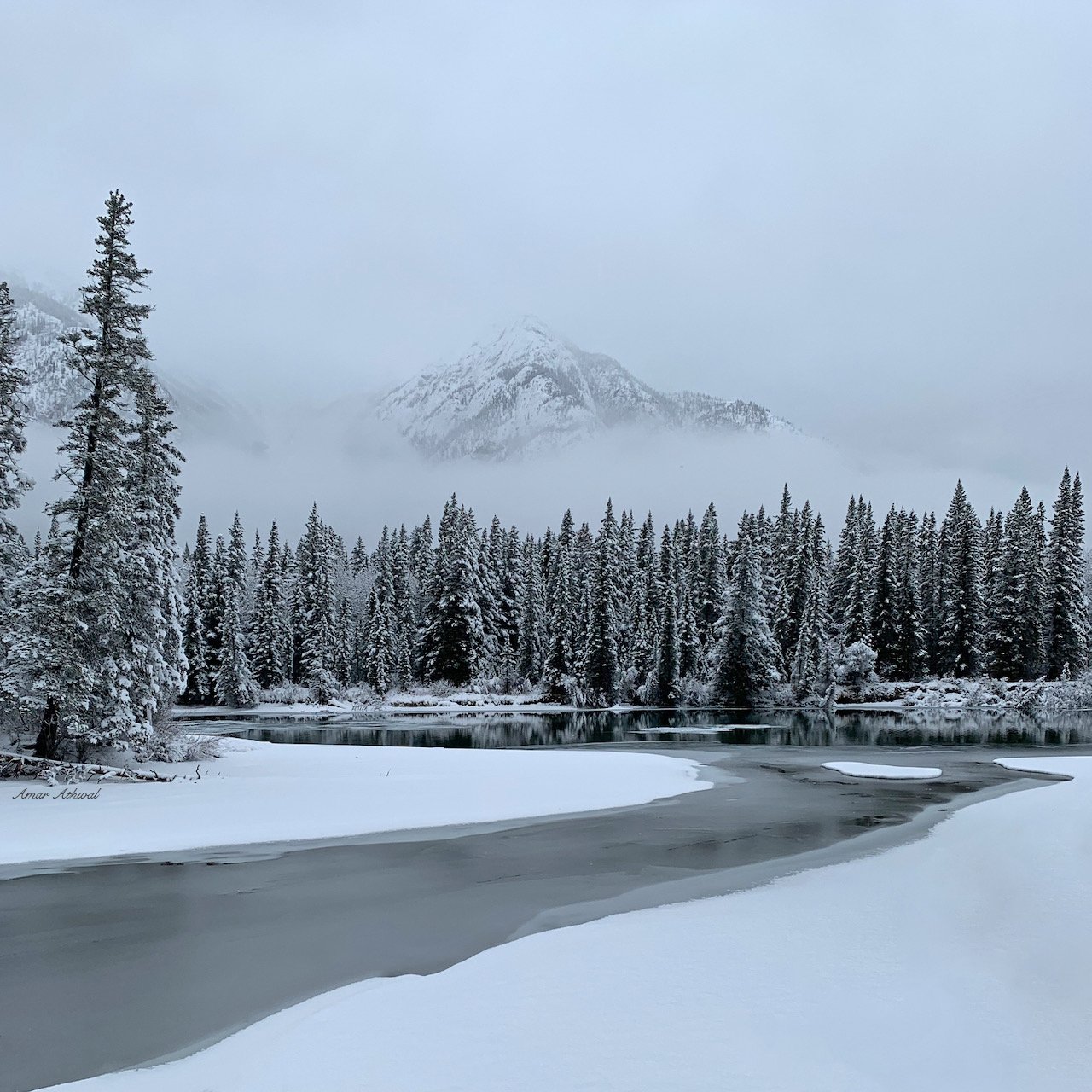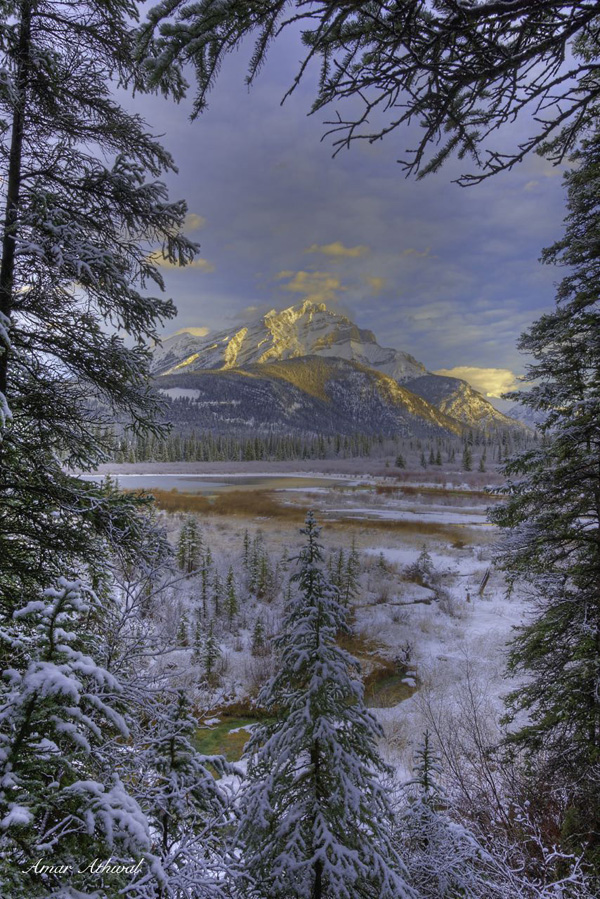It was my second attempt this winter to capture a sunrise picture with Mt. Wilson dominating the image. The mountain is located north of Saskatchewan Crossing, east of Highway 93 North, with the ice on the Saskatchewan River in the foreground. Windy mornings are quite common there, I find, and this morning was no exception. I was ready for that and actually enjoyed the wind as it blew loose snow over the ice in front of me. But the first morning light never reached the mountain or the clouds above Mt. Wilson. However, when I looked west toward Mt. Outram, about 15 km away, there was a beautiful warm pinkish glow. The sun’s light had made a long journey through the atmosphere, where shorter wavelengths, like that of blue, get scattered, while colours with longer wavelengths, like red and pink, are allowed to reach my eyes. And Mt. Outram, with Mt. Forbes just to the back right, provided the winter landscape. Another winter morning was enjoyed.
Bow Lake
It was great to be back up at 93 North—always a fantastic place to explore and find photography opportunities. It was also wonderful to see more snow than around home. While the snowpack is nowhere near its normal amount for this time of year, it still felt like the middle of winter while exploring the various areas. Normally, I would have needed my snowshoes to handle the snow, but this winter, I managed to get by without them every day. During one of my visits in the last few weeks, I aimed to capture sunrise pictures at Bow Lake. Bundled up, I still had time to find a spot and set up the camera before the sky began to light up. The sunrise did not disappoint.
Cascade Mtn
With all things being equal, the best light for photography in the Northern Hemisphere tends to be in winter. Even if we are only looking at the light at the start and end of the day, there's not only better light but also a longer window during which this light exists. This is due to the Sun being lower in the sky during winter. The lower angle of the Sun in winter better illuminates the features of the mountains compared to the summer light. Also, in winter, when snow is present, more light is reflected, reducing the chance of harsh shadows. This also means that if you like someone, you should be careful taking their picture in the middle of a sunny summer afternoon, when the Sun is more likely to cast harsh, dark shadows on their face.
Mount Rundle
We get some crazy sunrises during the winter. They are even better when everything is covered with snow. So far, this year's winter wonderland days have been few and far between. For me, a crazy sunrise and sunset occur when it's so bright, it becomes a challenge to get the bright colours with some details in the clouds in an image. You often see this when a picture is taken of a sunrise or a sunset. Instead of the bright red colours, you get yellow and the image is lacking in details where it's the brightest. That is why it’s always easier when the mountains and the trees are covered with snow. Then the lights bounce off the snow, creating less of a brightness difference between the sky and the ground. This was a long sunrise in mid-December. The clouds went from dark red to bright red and then to bright yellow. The clouds were lit up for about 20 minutes before the light hit the north side of Mount Rundle. By then, I had stopped taking pictures and just watched the light show in front of me.
Mount Aberdeen
We humans have already figured out how to make time go by quickly. You just have to stay busy. It feels like this picture was taken just a couple of weeks ago. But when I looked at the date, it was the start of October. I was coming down from the Big Beehive using a safer route, still above the low clouds that were in the Lake Louise area. On the way up early that morning, I heard a Northern Pygmy Owl. But there was still not enough light to explore to see if I could see it. So, descending a different route, I was not going to have a chance at possibly seeing the owl. But the great views more than made up for that. For some of the views, I just had to stop and take my camera out to get their pictures. This one was one of them. The trees in front of me and Mount Aberdeen were all covered with fresh snow. It was a winter wonderland on the morning of October 1, 2023.
Storm Mountain
Storm Mountain is located on the continental divide in the Bow Valley. It shares the boundary with Kootenay National Park and Banff National Park. I have never scrambled to the top but have enjoyed the hikes around the mountain. The last one was to Twin Lakes a few years back during the larch season. The mountain really stands out, thanks to its height (3,158 meters) and location. I’ll often look toward it in the morning for possible photo opportunities and whenever I can get to the mountain with the moon. For this image, I had forgotten to take a look at the mountain from a pull-off that gives a nice view of its Bow Valley facing side. A few minutes later, when I looked toward it, I realized I had to do a 180 to get the pictures of Storm Mountain. A black and white image was waiting for me at the pull-off.
Mount Rundle
Landscape photography, I find, is the most relaxing part of nature photography. I would go as far as saying it’s rather peaceful. It helps when I tend to look for spots with no one else around. That way, I can enjoy the sounds of nature while watching the scenery change and waiting for the sky or peaks to light up. Waiting and picking out the sounds of birds I can hear as my mind identifies them. That morning, thanks to all the spruce cones on the trees, crossbills were filling the air with their calls.
When I got to the parking lot for this image, no one else was in the area. I still went to a location where no one would follow. There were still twenty minutes to go before I thought the colours would pop on the clouds. There was one possible problem on that very windy morning. The ice I was standing on was not going anywhere, but the clouds were moving fast, heading east. The set of clouds that were there when I arrived, would be gone when the sunlight would hit them. But would the next set of clouds move into place? In the end, I missed out on the reds, but I did get the warm yellow colours to end the peaceful outing.
Mount Rundle
The Canadian Rockies, like many other places in Canada, are not having their normal winter. Well, it’s the case for much of the world. The "new norm”. I have not had too many opportunities to get out in the morning and see everything covered with snow this winter. So far, we've had above-average temperatures and below-average snowfall. The last time we got a decent snowfall was in the later part of December, when this picture was taken. Luckily, I had the day off following the snowfall, getting out and taking pictures wherever I could. I When we had normal winters, I never wanted them to end. Now, I try to get the most out of each snowfall. When everything looks like a postcard to my eyes.
Moon
With photography, I am self-taught and only when I share some of my images, others see my work. I still need to find a way to get better at my passion. As always, new technology can only take you so far. Being critical of my work is very important for my images to keep improving. Almost all my time related to photography is spent taking pictures and then working on images that I don’t delete. At the very least, I can say. I do not make a conscious effort to copy other photographer’s images. When I do have time, I’m more likely to study and look at painting than photography. Also, luckily my mind is weird enough, as those who know me can verify. I have my unique perspective on the world around me. Playing a big role in all the final images.
Sometimes I know right away I got a good image, but the true test is when I look at it on the monitor. If I’m not sure, I’ll let it stay on the drive for a few days and then get back to it. In the end, if the image I have taken is not something I want to show others, it will be deleted. Unless I get that rare slightly out of focus image of a unicorn, that image will be saved until I get a sharper one.
The day before I got this image, I must have walked for half an hour waiting to be in the right position to get the picture of the moon coming over the Sawback Range. I got several looks of the moon and the peaks. I went home and uploaded the images. I ended up deleting them all. I thought I could do better. The next day the moon would be rising a little later over the same mountain range, but this time I wanted to be on the other side of the valley and have the moon right above Mount Ishbel. A peak that had a triangle shape on top. The possible image in my head was more balanced.
Twenty-four hours later, I was ready to try again. Just as the moon started to come over the range, in less than five minutes I was in the position to get the picture I wanted. There was no question it was going to be black and white, giving it a better contrast between the snow and rocks and helping to bring out the clouds. As always, never being fully satisfied. I already have ideas on how I can make the image even better in the future. Just need mother nature’s cooperation.
Crowfoot Glacier
For this image of the Crowfoot Glacier or part of that glacier, it was a very relaxing experience. Sitting back and looking at the whole glacier. I watched the light and shadow change as the sun rose. Looking at the rock and ice in contrast to the exposed mountain side. Zooming in and out, trying to find a picture within a picture. A Common Raven was nearby, kept me company and hoped for food it never received. For a short period of time that day, the glacier had my full attention. As I thought about the first time I saw it and all the other times since, I have looked at it from below and face to face after hiking on the opposite side of the valley. Seeing it through all four seasons, winter time is the best by far. I love the colour of the old ice, somewhere between blue and green, and the warm colours in the exposed rocks. And those few trees on the right side, well, talk about growing in the extreme. I got the picture I wanted, and I had time for my mind to wander and relax.
The Moon
The Moon is called “the Moon” because we did not know other moons existed until 1610, when Galileo Galilei discovered four moons going around Jupiter. If you have one single pea and a nickel, then you have a good comparison of the Moon’s size to the Earth. The Moon is 27 percent the size of the Earth, the fifth largest moon in our solar system. The Moon is the only natural satellite of our favorite planet Earth. They are tidally locked, and thanks to their rotation being so synced, we can only see one side of the Moon. And thanks to the moon, Earth is a more livable planet by controlling Earth’s wobble on it’s axis. Helping to produce a stable climate. What’s been happening the last few decades on Earth, the moon takes no blame for that.
The Moon takes 27.3 days to make one revolution around the Earth, but 29.5 days to change from a New Moon to a New Moon. The reason for that is, both are moving around the Sun, and due to the change of positions, the sunlight hits the Moon at a different angle on day 27.3 than it does on day zero. Two more days are needed for sunlight to hit the Moon in the same way it did on day zero.
Why does the Moon look bigger when it’s setting, as in the attached image, or when rising? It’s due to the Moon illusion, a trick our brains play on us.
It’s always interesting how we’re connected to the nature around us, but also what’s in space. Only 12 human beings have walked on the moon, but every human on Earth has benefitted from the Moon, providing a safer place to call home.
Pilot Mtn
The day before ended with a great sunset, the sky was lit in all directions. Many of us got to enjoy nature’s light show. In the morning all conditions pointed to a bright sunrise to the east. With the day off, I decided I wanted to get a picture elsewhere. Challenging myself to try something different for creativity, which in the end is great for the mind and improves landscape photography as a whole. I still enjoy going to the popular places to take pictures, but getting something different, even of a mountain I have taken pictures of before, is a little extra special. As well, I have been having fun trying to get images in the more traditional panoramic aspect ratio of 6x17. Not simply taking a picture and then seeing if this ratio for cropping works, but having the cropping ratio in mind before taking the picture. Thanks to the low clouds and everything being covered with snow, this black and white image worked out well as a panorama.
After Snowfall
It’s funny, for many, sleeping in, sitting back or driving instead of exploring on foot, is about being comfortable. For me, once the alarm goes off, it’s time to get up. Otherwise, the body will be in pain. If I sit too long or go for a long drive, I go crazy. Feeling uncomfortable and constrained. But if I’m standing, walking, hiking or scrabbling, life is good. During the hiking season my motto is drive less, hike more. All my favorite hikes are about an hour drive or less. When I was younger, one of my goals was to live in an area where the outdoors was close. When the roads are bad, I can just walk out to an area and be surrounded by nature while others are deciding whether to hit the snooze button or get up. It’s one of the most amazing things about living in the mountains. Breaking trail after a snowfall, with snow covering everything around me. I’m in my elements. Comfortable elements.
Mount Victoria
Oh, how time flies, it was only a month ago waking up to an another morning with everything covered with snow. No better way to enjoy my favourite season. Now we are well into spring, but for those of us who have been living in the Canadian Rockies for a while, there is still a chance for more snow.I have experienced snow every month of the year number of times. But during winter, it’s extra special. This past winter produced many days to enjoy fresh fallen snow, to play in and to take pictures of. With the clouds running across the blue sky, snow covering every peak and trees in sight. That morning was made for black and white photography. Just as I was about to take the picture, I saw the snow falling off a tree on the right side of the image. It made the image that much special for me.
Snowflake
Last winter I found an another way to enjoy snow, snowflake photography. Most snowflakes are 1.3cm or less in size, come in many different shapes. I’m focused on the six sided snowflakes, the ones we think of during winter and even more during the holiday season. Bigger they are, easier to take their picture, but when I took this image, most were about 5mm or smaller. It was late morning and I was near the town of Banff, the temperature was just under minus 10 degrees Celsius and graupel was falling. Graupel is snow that looks like small white grain of sand. So I decided to head toward Lake Louise, part way there I stopped at a pull off. It was a few degrees colder, even better, gave me more time to locate and take a picture of the snowflakes before they had a chance to change. There I was next to my car, letting the snow fall on a glove liner. When I saw an interesting snowflake I would try to locate it with a hand held camera and micro lens combination. It’s a different but equally beautiful world. I had to make very small movements, I only had a millimetre or two of depth focus to work with. With this snowflake I took several pictures and still was not able to get everything in focus. Looking forward to many hours of practice, to improve my technique and as well my composition. But for now, here’s my first picture of a snowflake to share with you, a stellar dendrite.
Cascade Mountain
I don't have to go far to see nature. Over the years I have seen so much within km from my home. Just within 1000 meters from the spot I try to get 8 hours of sleep each night. I have seen over 100 species of birds, black bears, grizzlies, wolves, coyotes, foxes, a lynx and one evening a cougar while hiking down Tunnel Mtn. A frog, toad, salamander and a handful of fish, much of the time the fish were spotted in the mouths of a waterfowls. Various insects, all having an important role to play, even the ones who like to feed on our chocolate rich blood. Various, trees, shrubs, grasses and all those wildflowers. Still lots more, part of the families I have talked about and others I have not even mentioned. So much nature in such small space, let along the whole Banff National Park. Same goes for all those beautiful views, there is no end, this one was after two days of snowing.
Castle Mountain
There was a bit of pressure to quickly decide where I wanted to take the picture from. The little light that was on the mountain was gone and the clouds were soon going to cover the mountain. I started thinking in black and white and then moved around the open water until I had the composition that worked for me.
Moraine Lake
If one was waiting for a sunny day to hike in this fall, not much hiking would get done. I stopped listening to weather forecaster long time ago, for only so long I could listen to a person in the morning telling me if the temperature and the other elements of weather was just not right it was not a good day. I don't get many days to hike, there's no way I'm going to let a person decide what type of day I will have outdoors. I look up the weather in the morning to help me decide what to wear and then head out to have a great day. The day this picture was taken, we headed out to make the most of the day after snow had fallen and more was on the way and the clouds blanketed most of the mountains. We spend the morning exploring the mountains and got to enjoy great views.
Cascade Mountain
Its always good to get back to landscape photography, that's where it all started for me many years ago. Around the town of Banff there are two mountains that get most of the attention for landscape photography, Mount Rundle and Cascade. I have hundreds of pictures of Rundle but only in the tens for Cascade. In my effort to change that balance, I have been looking at different ways I can take pictures of Cascade. Cascade Mountain always looks better in winter, this one is during a sunrise
Until next moment,
Amar
Nature's Art

Nature was putting on a art show, the medium was ice. Using methane gas bubbles and crack to come up with unlimited variety of abstract images to look at. One could spend days and still not capture what was there. This picture is just a taste of what I saw.
Until next moment,
Amar
